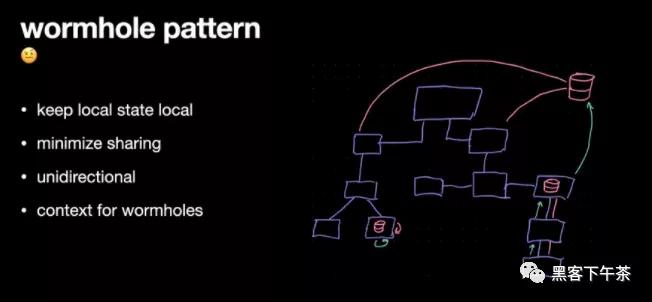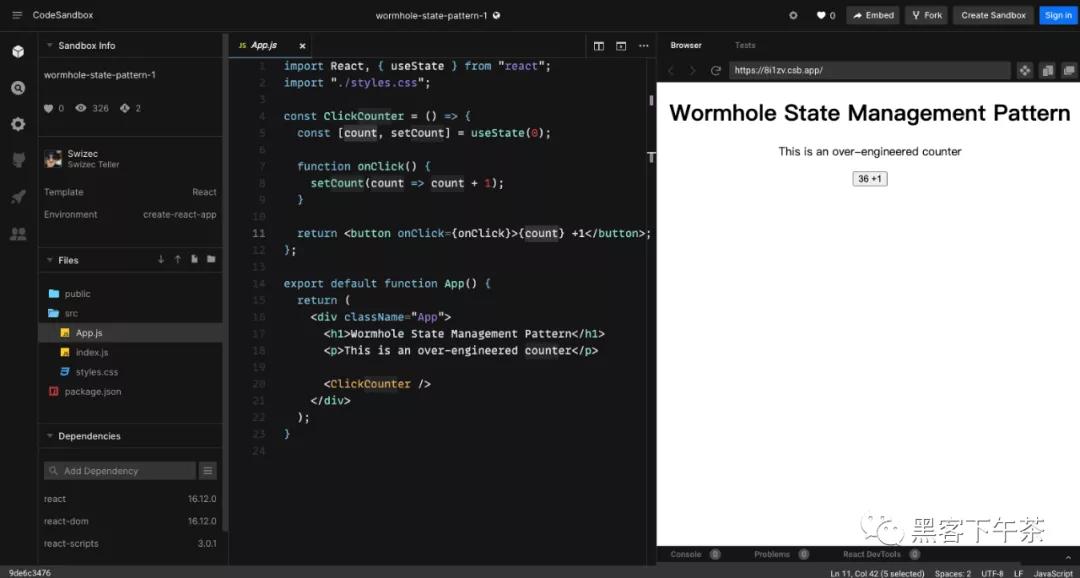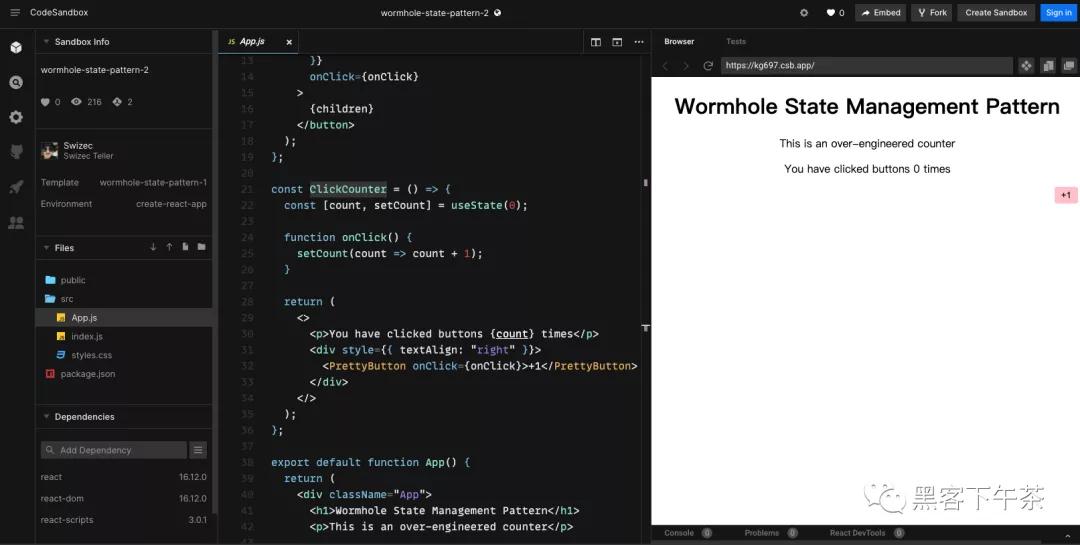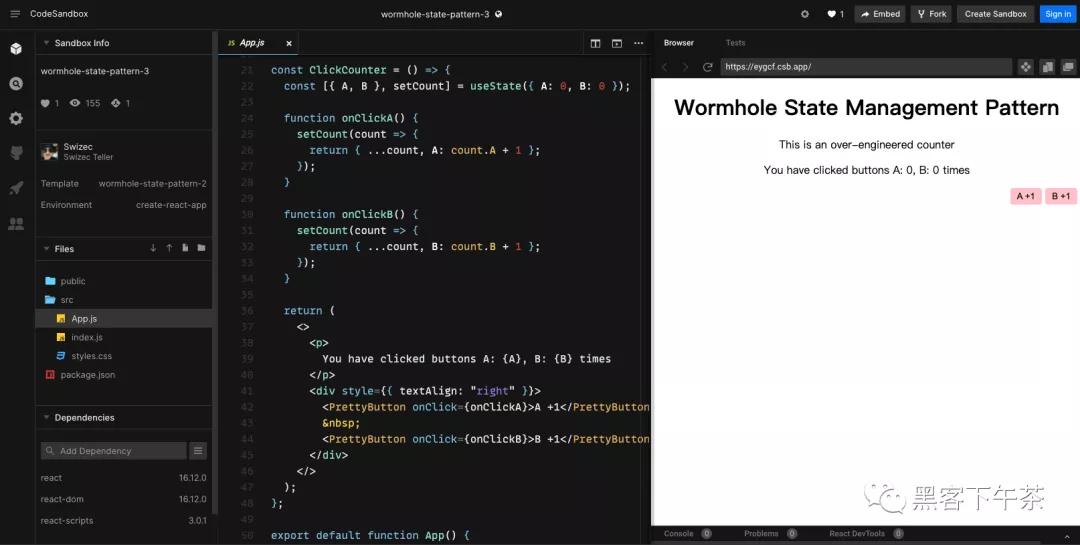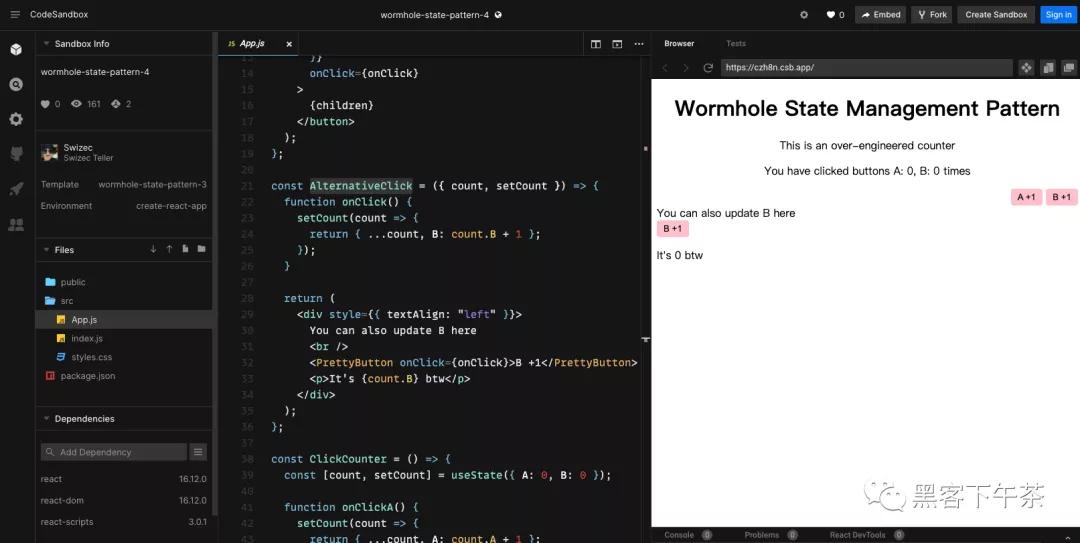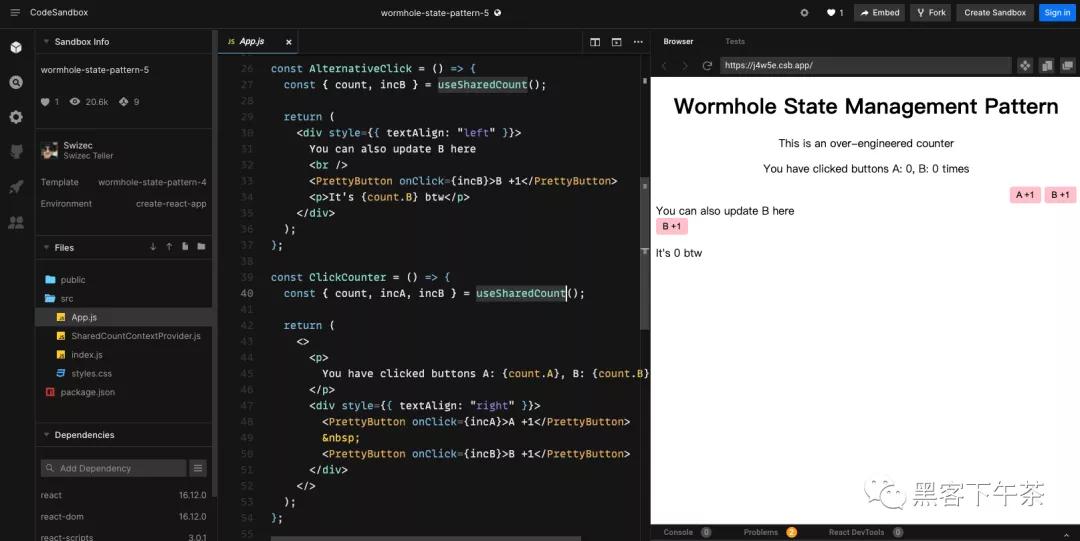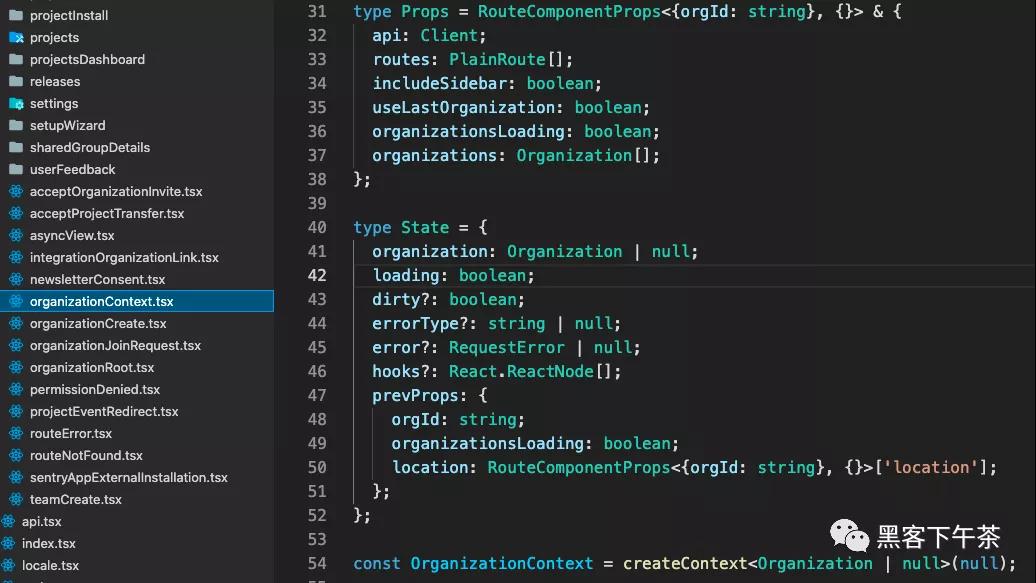什么是虫洞状态管理模式?
您可以逃脱的最小 state 共享量是多少?
保持你的 state。尽可能靠近使用它的地方。
如果有一个组件关心这个问题,使用它。如果有几个组件在意,就用 props 分享一下。如果很多组件都关心,把它放在 context 中。
Context 就像一个虫洞。它使您的组件树弯曲,因此相距很远的部分可以接触。
利用自定义 hooks 使这变得容易。
一个例子
构建一个点击计数器。虫洞状态管理模式最好通过示例来解释 ??
CodeSandbox(示例代码)
- https://codesandbox.io/s/wormhole-state-pattern-5-j4w5e?file=/src/App.js
步骤 1
我们从 useState 开始,因为它是最简单的。
- const ClickCounter = () => {
- const [count, setCount] = useState(0);
- function onClick() {
- setCount(count => count + 1);
- }
- return <button onClick={onClick}>{count} +1</button>;
- };
count 保存当前的点击次数,setCount 让我们在每次点击时更新值。
足够简单。
不过,外观并不是很漂亮。让我们用一个自定义按钮组件和一些嵌套来改进它。
步骤 2
我们创建了一个可重复使用的 PrettyButton,确保您应用中的每个按钮看起来都很棒。
状态保留在 ClickCounter 组件中。
- const ClickCounter = () => {
- const [count, setCount] = useState(0);
- function onClick() {
- setCount(count => count + 1);
- }
- return (
- <>
- <p>You have clicked buttons {count} times</p>
- <div style={{ textAlign: "right" }}>
- <PrettyButton onClick={onClick}>+1</PrettyButton>
- </div>
- </>
- );
- };
这是必要的最少状态共享。我们也保持了简单的状态。
计数器组件关心点击次数和计数,因此它将回调作为 props 传递到按钮中。函数被调用,状态更新,组件重新渲染。
不需要复杂的操作。
步骤 3
如果我们的状态更复杂怎么办?我们有 2 个属于一起的项。
您可以在您的状态中保留复杂的值。效果很好。
- const ClickCounter = () => {
- const [count, setCount] = useState(0);
- function onClick() {
- setCount(count => count + 1);
- }
- return (
- <>
- <p>You have clicked buttons {count} times</p>
- <div style={{ textAlign: "right" }}>
- <PrettyButton onClick={onClick}>+1</PrettyButton>
- </div>
- </>
- );
- };
我们已将 count 拆分为一个对象 – { A, B }。
现在单个状态可以保存多个值。单独按钮点击的单独计数。
React 使用 JavaScript 相等来检测重新渲染的更改,因此您必须在每次更新时制作完整状态的副本。这在大约 10,000 个元素时变慢。
您也可以在这里使用 useReducer。特别是当您的状态变得更加复杂并且项目经常单独更新时。
使用 useReducer 的类似状态如下所示:
- const [state, dispatch] = useReducer((action, state) => {
- switch (action.type) {
- case 'A':
- return { ...state, A: state.A + 1 }
- case 'B':
- return { ...state, A: state.A + 1 }
- }
- }, { A: 0, B: 0})
- function onClickA() {
- dispatch({ type: 'A' })
- }
你的状态越复杂,这就越有意义。
但我认为那些 switch 语句很快就会变得混乱,而且你的回调函数无论如何都已经是动作了。
步骤 4
如果我们想要 2 个按钮更新相同的状态怎么办?
您可以将 count 和 setCount 作为 props 传递给您的组件。但这变得越来越混乱。
- const AlternativeClick = ({ count, setCount }) => {
- function onClick() {
- setCount(count => {
- return { ...count, B: count.B + 1 };
- });
- }
- return (
- <div style={{ textAlign: "left" }}>
- You can also update B here
- <br />
- <PrettyButton onClick={onClick}>B +1</PrettyButton>
- <p>It's {count.B} btw</p>
- </div>
- );
- };
我们创建了一个难以移动并且需要理解太多父逻辑的组件。关注点是分裂的,抽象是奇怪的,我们造成了混乱。
你可以通过只传递它需要的状态部分和一个更自定义的 setCount 来修复它。但这是很多工作。
步骤 5
相反,您可以使用虫洞与自定义 hook 共享状态。
您现在有 2 个共享状态的独立组件。将它们放在您的代码库中的任何位置,它 Just Works?。
需要在其他地方访问共享状态?添加 useSharedCount hook,瞧。
这是这部分的工作原理。
我们有一个 context provider,里面有一些操作:
- export const SharedCountProvider = ({ children }) => {
- // replace with useReducer for more flexiblity
- const [state, setState] = useState(defaultState);
- const [contextValue, setContextValue] = useState({
- state,
- // dispatch // from your reducer
- // this is where a reducer comes handy when this grows
- setSharedCount: (key, val) => {
- setState(state => {
- return { ...state, [key]: val };
- });
- }
- // other stuff you need in context
- });
- // avoids deep re-renders
- // when instances of stuff in context change
- useEffect(() => {
- setContextValue(currentValue => ({
- ...currentValue,
- state
- }));
- }, [state]);
- return (
- <SharedCountContext.Provider value={contextValue}>
- {children}
- </SharedCountContext.Provider>
- );
- };
Context Provider 使用丰富的 state 变量来保持您的状态。这里对我们来说是 { A, B }。
contextValue 是一个更丰富的状态,它也包含操作该状态所需的一切。通常,这将是来自您的 reducer 的 dispatch 方法,或者像我们这里的自定义状态设置器。
我们的 setSharedCount 方法获取一个 key 和一个 val 并更新该部分状态。
- setSharedCount("B", 10);
然后我们有一个副作用,它观察 state 的变化并在需要时触发重新渲染。这避免了每次我们重新定义我们的 dispatch 方法或其他任何东西时的深度重新渲染。
使 React 树更稳定 ??
在这个 provider 中呈现的每个组件都可以使用这个相同的自定义 hook 来访问它需要的一切。
- export function useSharedCount() {
- const { state, setSharedCount } = useContext(SharedCountContext);
- function incA() {
- setSharedCount("A", state.A + 1);
- }
- function incB() {
- setSharedCount("B", state.B + 1);
- }
- return { count: state, incA, incB };
- }
自定义 hook 利用 React Context 共享状态,定义更简单的 incA 和 incB 辅助方法,并返回它们的状态。
这意味着我们的 AlternativeClick 组件可以是这样的:
- import {
- useSharedCount
- } from "./SharedCountContextProvider";
- const AlternativeClick = () => {
- const { count, incB } = useSharedCount();
- return (
- <div style={{ textAlign: "left" }}>
- You can also update B here
- <br />
- <PrettyButton onClick={incB}>B +1</PrettyButton>
- <p>It's {count.B} btw</p>
- </div>
- );
- };
从自定义 hook 获取 count 和 incB。使用它们。
性能怎么样?
很好。
尽可能少地共享 state。对应用程序的不同部分使用不同的 context provider。
不要让它成为 global,除非它需要是 global 的。包裹你可以逃脱的树的最小部分。
复杂度如何?
什么复杂度?保持小。不要把你不需要的东西塞进去。
讨厌管理自己的状态
看到我们 SharedCountProvider 中处理状态变化的部分了吗?这部分:
- const [contextValue, setContextValue] = useState({
- state,
- // dispatch // from your reducer
- // this is where a reducer comes handy when this grows
- setSharedCount: (key, val) => {
- setState(state => {
- return { ...state, [key]: val };
- });
- }
- // other stuff you need in context
- });
为此,您可以使用 XState。或者 reducer。甚至 Redux,如果你真的想要的话。
不过,如果你使用 Redux,你不妨一路走下去 ??
顶级开源项目是如何使用的?(Sentry)
organizationContext.tsx(详细代码)
- https://github.com/getsentry/sentry/blob/master/static/app/views/organizationContext.tsx
Refs
Wormhole state management
https://swizec.com/blog/wormhole-state-management/














